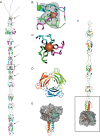A novel Alteromonas phage with tail fiber containing six potential iron-binding domains
- PMID: 39565130
- PMCID: PMC11705849
- DOI: 10.1128/spectrum.00934-24
A novel Alteromonas phage with tail fiber containing six potential iron-binding domains
Abstract
Viruses play a vital role in regulating microbial communities, contributing to biogeochemical cycles of carbon, nitrogen, and essential metals. Alteromonas is widespread and plays an essential role in marine microbial ecology. However, there is limited knowledge about the interactions of Alteromonas and its viruses (alterophages). This study isolated a novel podovirus, vB_AmeP-R22Y (R22Y), which infects Alteromonas marina SW-47 (T). Phylogenetic analysis suggested that R22Y represented a novel viral genus within the Schitoviridae family. R22Y exhibited a broad host range and a relatively large burst size, exerting an important impact on the adaptability and dynamics of host populations. Two auxiliary metabolic genes, encoding Acyl carrier protein and AAA domain-containing protein, were predicted in R22Y, which may potentially assist in host fatty acid metabolism and VB12 biosynthesis, respectively. Remarkably, the prediction of the R22Y tail fiber structure revealed six conserved histidine residues (HxH motifs) that could potentially bind iron ions, suggesting that alterophages may function as organic iron-binding ligands in the marine environment. Our isolation and characterization of R22Y complements the Trojan Horse hypothesis, proposes the possible role of alterophages for marine iron biogeochemical cycling, and provides new insights into phage-host interactions in the iron-limited ocean.IMPORTANCEIron (Fe), as an essential micronutrient, is often a limiting factor for microbial growth in marine ecosystems. The Trojan Horse hypothesis suggests that iron in the phage tail fibers is recognized by the host's siderophore-bound iron receptor, enabling the phage to attach and initiate infection. The potential role of phages as iron-binding ligands has significant implications for oceanic trace metal biogeochemistry. In this study, we isolated a new phage R22Y with the potential to bind iron ions, using Alteromonas, a major siderophore producer, as the host. The tail fiber structure of R22Y exhibits six conserved HxH motifs, suggesting that each phage could potentially bind up to 36 iron ions. R22Y may contribute to colloidal organically complexed dissolved iron in the marine environment. This finding provides further insights into the Trojan Horse hypothesis, suggesting that alterophages may act as natural iron-binding ligands in the marine environment.
Keywords: Alteromonas; bacteriophage; interaction; iron; tail structure.
Conflict of interest statement
The authors declare no conflict of interest.
Figures







Similar articles
-
A Novel Phage Infecting Alteromonas Represents a Distinct Group of Siphophages Infecting Diverse Aquatic Copiotrophs.mSphere. 2021 Jun 30;6(3):e0045421. doi: 10.1128/mSphere.00454-21. Epub 2021 Jun 9. mSphere. 2021. PMID: 34106770 Free PMC article.
-
A Novel Alteromonas Phage Lineage with a Broad Host Range and Small Burst Size.Microbiol Spectr. 2022 Aug 31;10(4):e0149922. doi: 10.1128/spectrum.01499-22. Epub 2022 Jul 11. Microbiol Spectr. 2022. PMID: 35862972 Free PMC article.
-
A Novel Broad Host Range Phage Infecting Alteromonas.Viruses. 2021 May 26;13(6):987. doi: 10.3390/v13060987. Viruses. 2021. PMID: 34073246 Free PMC article.
-
Phage puppet masters of the marine microbial realm.Nat Microbiol. 2018 Jul;3(7):754-766. doi: 10.1038/s41564-018-0166-y. Epub 2018 Jun 4. Nat Microbiol. 2018. PMID: 29867096 Review.
-
Understanding Bacteriophage Tail Fiber Interaction with Host Surface Receptor: The Key "Blueprint" for Reprogramming Phage Host Range.Int J Mol Sci. 2022 Oct 12;23(20):12146. doi: 10.3390/ijms232012146. Int J Mol Sci. 2022. PMID: 36292999 Free PMC article. Review.
References
MeSH terms
Substances
LinkOut - more resources
Full Text Sources
Medical

